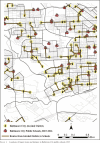Evaluation of a Local Ordinance to Prevent Any Underage Purchases in Liquor Stores: The Need for Enforcement
- PMID: 33823969
- PMCID: PMC8864619
- DOI: 10.15288/jsad.2021.82.219
Evaluation of a Local Ordinance to Prevent Any Underage Purchases in Liquor Stores: The Need for Enforcement
Abstract
Objective: In June 2012, Baltimore City, MD, enacted legislation (commonly referred to as the Mosby Bill) prohibiting all liquor stores (outlets that primarily sell alcoholic beverages) from selling "any food, goods, wares, supplies, or other merchandise to any person under the age of 18." Three years after enactment, we evaluated the impact of this legislation on non-alcohol product sales among youth.
Method: Research assistants (RAs) ages 16-20 were trained in using a standardized observational tool to quantify and record characteristics of the outlets, including products sold. A trained pair comprising one RA age 16 to 20 and one RA exactly age 18 were sent into every liquor store (i.e., packaged goods stores and bar/taverns with packaged goods sales) in Baltimore to conduct the assessment and make a non-alcohol purchase. Since the research was not conducted in concert with the police, the 18-year-old RA made the purchase attempt while the other (age 16 to 20) RA completed the assessment.
Results: Purchase attempts were made at 502 liquor stores, and 352 of those attempts were successful (able to make purchase without being asked for identification or age; noncompliance rate = 68.1%). Noncompliance was highest among packaged goods stores compared with bar/taverns, and in neighborhoods with a lower median household income and a higher proportion of African American residents (p < .050). Noncompliant outlets were also located closer to public schools (p < .050).
Conclusions: This evaluation demonstrates that, in the absence of enforcement, ordinances are neither likely to be honored nor to achieve the intended public health benefits.
Figures
Similar articles
-
Using Zoning as a Public Health Tool to Reduce Alcohol Outlet Oversaturation, Promote Compliance, and Guide Future Enforcement: a Preliminary Analysis of Transform Baltimore.J Urban Health. 2020 Aug;97(4):568-582. doi: 10.1007/s11524-020-00453-7. J Urban Health. 2020. PMID: 32632795 Free PMC article.
-
Using Zoning as a Public Health Tool to Reduce Oversaturation of Alcohol Outlets: an Examination of the Effects of the New "300 Foot Rule" on Packaged Goods Stores in a Mid-Atlantic City.Prev Sci. 2019 Aug;20(6):833-843. doi: 10.1007/s11121-018-0947-9. Prev Sci. 2019. PMID: 30284159 Free PMC article.
-
Underage purchasing of alcohol from packaged liquor outlets: an Australian study.Health Promot Int. 2017 Oct 1;32(5):790-799. doi: 10.1093/heapro/daw007. Health Promot Int. 2017. PMID: 27006362
-
Remote age verification to prevent underage alcohol sales. First results from Dutch liquor stores and the economic viability of national adoption.Int J Drug Policy. 2015 Apr;26(4):364-70. doi: 10.1016/j.drugpo.2014.08.013. Epub 2014 Sep 1. Int J Drug Policy. 2015. PMID: 25256559
-
Mystery shopping and alcohol sales: do supermarkets and liquor stores sell alcohol to underage customers?J Adolesc Health. 2007 Sep;41(3):302-8. doi: 10.1016/j.jadohealth.2007.04.007. Epub 2007 Jul 12. J Adolesc Health. 2007. PMID: 17707301
References
-
- Anderson P., de Bruijn A., Angus K., Gordon R., Hastings G. Impact of alcohol advertising and media exposure on adolescent alcohol use: A systematic review of longitudinal studies. Alcohol and Alcoholism . 2009;44:229–243. doi:10.1093/alcalc/agn115. - PubMed
-
- Baltimore City Council. Sales to minors in proximity of liquor store . 2012, June 26. Retrieved from https://baltimore.legistar.com/Legislation-Detail.aspx?ID=2177427&GUID=7....
-
- Baltimore City. Baltimore open data . 2018. Retrieved from https://data.baltimorecity.gov.
-
- Baltimore City Department of Planning. n.d. Zoning summary. https://planning.baltimorecity.gov/sites/default/files/RZONINGSUMMARY.pdf.
-
- Beaudette J. November 12). “Overview of the U.S. beverage alcohol market, trends & market entry conditions” (presentation at the Beverage Alcohol Community Symposium . New York, NY): 2015.
Publication types
MeSH terms
Grants and funding
LinkOut - more resources
Full Text Sources
Miscellaneous


